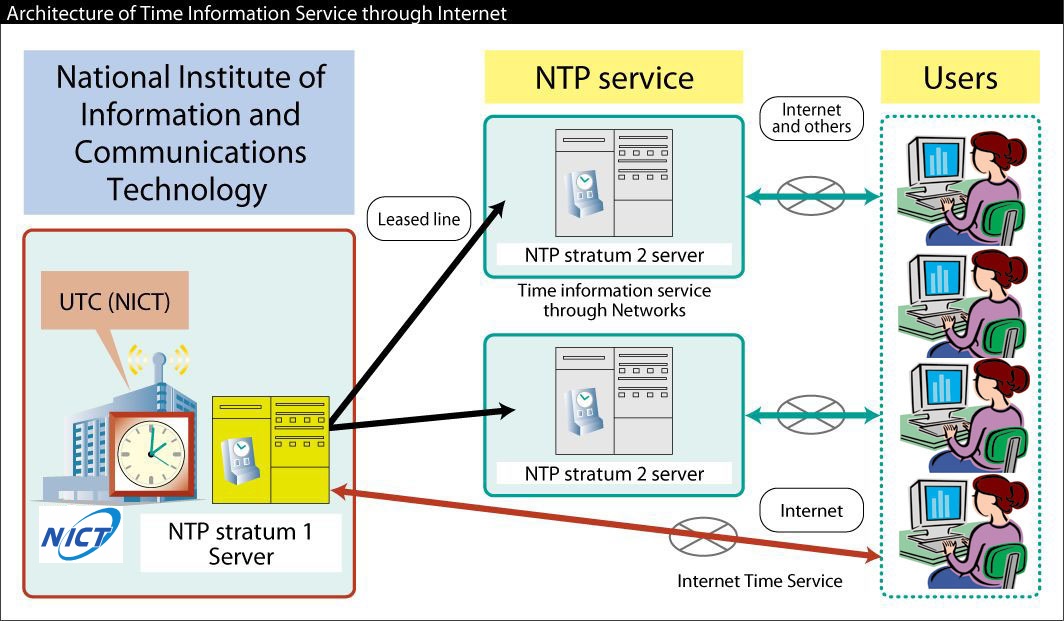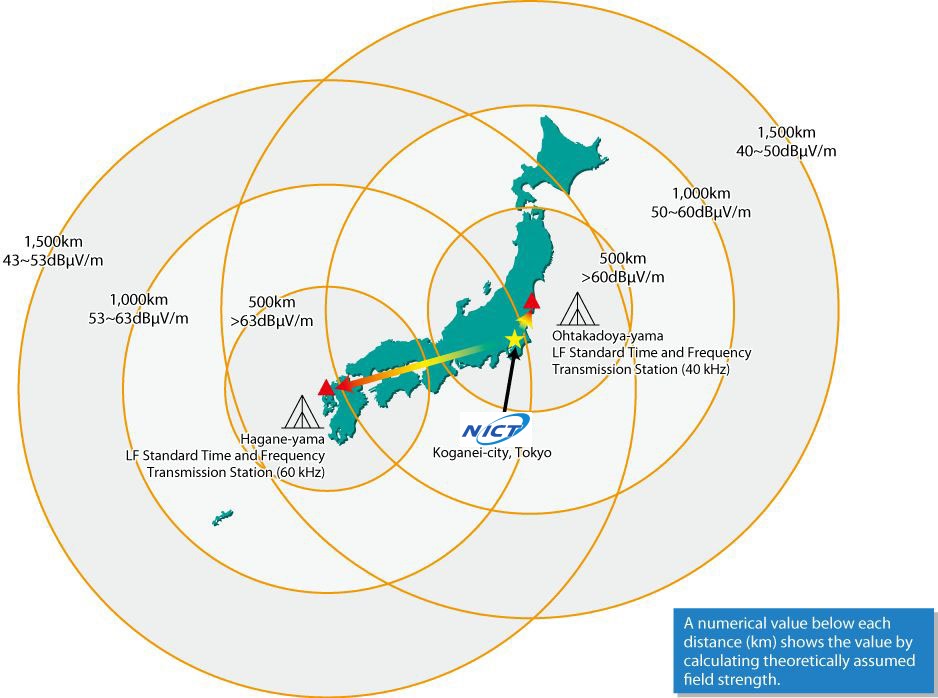Mission of Japan Standard Time Group
Dissemination of JST
- Low-Frequency Standard Time and Frequency Transmission Stations
The standard time and frequency transmission (JJY*) is a radio wave to
supply the standard frequency and JST throughout Japan.
The primary clock of broadcast
stations and telephone is synchronized with JST by reception of this standard
radio wave.
Ohtakadoya-yama
LF Standard Time and Frequency Transmission Station has transmitted the standard wave (40 kHz) since June 1999.
Hagane-yama LF Standard Time and Frequency Transmission Station has transmitted the standard wave (60 kHz) since October 2001.
The LF standard time and
frequency transmission signal includes a time code which contains the following
information; minute, hour, annual date (counted from January 1), year (last 2
digits of the dominical year), and day of the week. This time code is used for reception
devices such as radio controlled clocks with automatic time correction
functions.
The time code signal is expected
to contribute to a wide range of applications, such as clocks in home electronic
appliances, cameras, automobile clocks, and the built-in clocks of measuring
instruments and seismometers. The standard frequency supplied by the LF
standard time and frequency transmission signal is also expected to serve as a
precise frequency standard for a variety of applications: measuring
instruments, communication devices, standards for the master standard devices
of electronic manufacturers, standard oscillators of ground-based digital broadcasting,
and highly precise frequency standards.
For your reference: although
the LF standard time and frequency transmission signal has ordinarily been transmitted
for 24 hours a day, it may temporarily be interrupted because of maintenance work
on devises and antennas, or measures against lightning storms.
*JJY is the call sign of the radio station and form a registered trademark(T4355749) of the NICT
(Click the picture above to see larger picture)
- Internet Time Service
In today’s computerized society, most computers transfer every data via
networks. During these processes, file update times are usually defined
by the built-in clocks of the individual computers. However, these built-in
clocks of PCs are not highly precise, and so, without regular periodic
time synchronization, inconsistencies are bound to occur in file information.
Therefore, the use of NTP (Network Time Protocol) has spread so as to synchronize
the time of networked computers. (Click the picture above to see larger picture)
Conventionally, high-frequency (HF) standard transmissions were widely used to synchronize clocks for business plications, such as the master clocks of broadcasting stations. On August 1, 1995, a new system came into operation, supplying a high-precision time signal electronically via analog telephone lines (telephone JJ:). A personal computer, modem, and commercial communications software are all that is required for users to acquire time information with precise adjustment for delays in the telephone line.
For higher precision and stability of time dissemination, NICT had developed Hikari telephone JJY and started experimental operation in May 2016. As part of the standard frequency dissemination activity, NICT provides calibration services of the frequency standard.
Broadcasting stations and radio stations should broadcast and communicate with accurate radio frequencies, as stipulated in Radio Act.
By calibration of their frequency standards with respect to the national frequency standard maintained by NICT, we ontribute to citizen’s life.
The types of frequency calibration services are as follows.
The Japan Standard Time Group(JSTG) offers “Time Information Service by Networks” to time-dissemination
enterprises authorized as Time Business, and internet related corporations.
Through this service, stable time information is provided by
directly connecting users’ servers with an NTP server linked up
with JST. The JSTG also offers an “Internet Time Service” to
general users so that they too are able to use an NTP server
(ntp.nict.jp) that links up with JST.


Dedicated receivers for commercial use perform time synchronization using JST with precision of less than one illisecond,
equivalent to the precision of conventional commercial HF receivers, by measuring and correcting the delay in communication lines using the bi-directional telephone connection. Although dedicated receivers were widely used in commercial applications, especially at broadcasting stations, the Telephone JJY service was terminated on March 31, 2024.
Hikari telephone JJY has been in official operation since February 2019. After Telephone JJY ends in March 2024, Hikari telephone JJY will be the single service using the telephone line.
Hikari telephone JJY realized the stable dissemination, and reduction of down time of the service due to high-speed data communication and backup redundancy of the host system.
1) Calibration based on the Radio Act
2) Calibration based on Article 135 of the Measurement Act
(jcss* calibration)
3) Calibration based on CIPM**-MRA*** (ASNITE****calibration)
4) Commissioned calibration.
* jcss: Japan Calibration Service System using National Standard
**CIPM: International Committee for Weights and Measures
***MRA: Mutual Recognition Arrangement
****ASNITE: Accreditation System of National Institute of Technology and
Evaluation
In 2), NICT is a designated calibration organization authorized by the Minister of Economy, Trade and Industry. We issue calibration certificates to a client necessary for
operating as a registered operator stipulated by the Measurement Law.
In 3), our calibration system is accredited in accordance with the international standard ISO / IEC 17025: 2017 (JIS Q 17025: 2018). Based on it, we issue a calibration certificate that supports international mutual recognition.
In addition to frequency calibration, short-term stability measurement service is also available in the type 4).
For more information, please visit our website below.
https://cal.nict.go.jp (Japanese version only)

